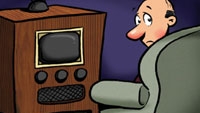Embrace change or be left behind
I have been following the recent analog switchoff in a small region of the UK. The analog shutoff is protracted as region-by-region digital transmitter power is increased and the analog transmitters are closed down. To avoid interference, the process will take more than four years. Many countries have taken a big bang approach: If the public is going to be upset, get it over with as quickly as possible.
The response from viewers has been illuminating. Listening to a radio phone-in shed some light on consumer attitudes about technology. As broadcast engineers, we might operate as if everyone were watching a flat-screen 1080p display coupled to an HD PVR, satellite receiver, cable STB and IPTV terminal, all with 5.1 surround sound. Of course, most of the public have a rudimentary level of knowledge — at best — with the technological change at hand.

During the phone-in show, I heard folks complaining that they had a perfectly good monochrome receiver with plenty of life left in it. Another person had a 15-year-old color receiver that was still going strong. I dread to wonder at the colorimetry and convergence, but for some people, as long as the pictures are colored, that's OK.
You could say the discomfort is inevitable as 20th century technology is replaced by 21st. But many don't like change. They also resent the cost. The past expectation has been that a receiver will last at least 12 years. A new digital receiver costs from €200. Even with a life of five years, that is less than €1 a week — hardly an imposition. Digital STB prices are about €30 or less.
Many older viewers are used to buying long-lasting consumer goods. If they failed, they were repaired. The price of repairing modern products is rarely worthwhile. The labor cost is too high compared with just replacing it with a new unit. This change to the throwaway society jars many people. They are joined by the greens who are complaining about waste plus the power consumption of flat-screen displays.
These issues are clouding and confusing the digital switchover. The benefit of digital, with at least four times the number of channels for a given bandwidth, cuts little ice for those who are content with watching the prime networks.
It is unfortunate that some of the disadvantaged in society may suffer. However, if they can be compensated with an STB grant or some similar help, we can all receive the advantages of a newer transmission technology. Some governments have decided to compensate viewers, a simple matter to fund from the auction of spectrum. What elected representative wants to explain to a voter that he is going to lose his television? In the United States, qualifying viewers receive two coupons worth E28 for STBs. However, other governments have decided not to share the digital dividend, but to pass it on to the treasury.
The professional video industry's #1 source for news, trends and product and tech information. Sign up below.
It seems that the digital switchover is going to be more than just a change of modulation scheme. It encompasses many of the issues that the 20th century man faces as we embrace a new age. If you like change, it's a world of opportunities. For the technophobic consumers, however, the digital switchover adds nothing but cost.
Send comments to:editor@broadcastengineeringworld.com
View more Viewpoints.
